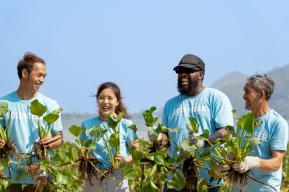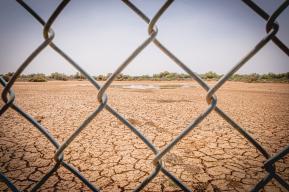At UNESCO, we value sharing the inspirational stories of young people who are positively impacting the world or shedding light on important issues. We want to amplify powerful youth voices by giving them the space and platform to express themselves to have a greater impact on the world. This is why we are collaborating with Tamara by following her incredible journey overwintering in the Arctic in this web stories series.
This is the boat that allowed me to fear death and go beyond it. To face solitude and discover the power of friendship. She made me feel miserable for knowing so little and taught me to embrace the freedom of being young. Every great sailor was one day a beginner in their field. This boat permitted me to begin.
Yesterday, I crossed the Arctic Circle single-handed. One might say this boat is too small, too weak, too old. And one might look at me and say I’m too small, too weak, too young. And I understand them, because before starting this trip, from France to West Greenland, I asked myself if the plan was too ambitious. I would study, practice, ask more experienced people for advice, count on my friends, try it out, learn from my mistakes, and try it again, differently. Once a day, I would write in my journal I was scared. Once a day, I would find out I was capable of doing things I didn’t know I could. The preparation and teamwork made me capable of it.
My arrival to Greenland was surprisingly revealing of the state of our society. After sailing for 13 days between Ireland and the south of Greenland without seeing a face or hearing the voice of anyone, I was excited to finally get to a village and meet humans. As I approached Qaqortoq, I was hypnotized by dark clouds and the red brightness of what seemed to be an active volcano. Getting closer to it, I felt the scent of smoked plastic and realized that the eruption was a mountain of burning trash. It was obvious, but it became undeniable: It doesn’t matter how far we travel, where there is a linear economy and consumerism, there will be trash. In remote areas like here, this rejected material is transported back to Denmark, using thousands of liters of diesel, or it burns by accident, damaging air quality. In less remote cities, it is easier to hide this trash from our sight as fast as possible and forget it. But it still exists, and will keep existing much longer than us on this planet. My first image of a settlement was not as welcoming as I expected. But it was rough, it was real, and it illustrates the problem with having a linear approach to design and consumption instead of an understanding of, and consideration for life cycles.

In the following days, I would learn that the landscapes I’m seeing now could disappear in the next 10 years. I sailed between many icebergs that were coming from the glacier front. As I entered its fjord, my charts indicated I was sailing on land. I would later find out that in the year the charts were made, there was a big glacier where now there is only water. The elderly in the city of Ilulissat describe the colossal icebergs that they used to see two decades ago and will never seen again, as the ice falling means the retracted glacier is smaller every year. Local fisherman recall dog sledding throughout Disko Bay on winter sea ice three decades ago, but the sea ice became too thin and does not freeze completely anymore. Scientists and hunters have observed different behaviours in polar bear populations as they get closer to land and settlements once the sea ice becomes too thin for them to move on it. In the Arctic, the effects of global temperature changes are fast and visible, but devastating consequences happen to populations worldwide. And what we can see above the sea level is a small part of transformations that are happening under the surface and affect every place where water exists.

The summer season is now approaching its end, and I’m preparing the boat and myself to stay stuck on the sea ice for the seasons to come. As I searched for a place to overwinter, I studied which areas would freeze and for how long, and investigated how to increase my autonomy and reduce the impact of my presence in a remote place through low technology, how to measure the thickness of the sea ice and how to be mentally prepared to face 200 days of solitude and the darkness of the Arctic winter. Through this preparation, I met brilliant, experienced and generous people who gave me invaluable support, and also met some who questioned whether I would be capable of staying alone for eight months due to my female body and the risk of being more ‘vulnerable’ than the male sailors that overwintered before. Even though I’m conscious that the sea is indifferent to my gender, my size, or my age, these comments could be discouraging. Thanks to previous generations of women who opened new paths to us in every field, we face fewer social and cultural barriers than ever before. Nowadays, everything seems more possible to girls than in the past. But some limiting beliefs are still to be overcome and I’m persuaded that sharing our stories is a powerful tool to make it happen.
I write this text while listening to the boat brushing the sea ice and the wind descending the mountains from the ice sheet. Learning how to use finite resources wisely, adapting to environmental transformations, and questioning the limits of what a woman can do single-handed will be my daily challenge in this overwintering and the challenge of our whole generation.
UNESCO and Youth
For over 20 years, UNESCO has been working actively to ensure that youth voices are heard because they matter.
By following Tamara’s journey to the Arctic, UNESCO aims to provide her with a space to raise her concerns about climate change and to amplify her voice. Her powerful actions to increase awareness about the damages of the climate crisis show how youth are major partners in tackling this issue.
This year, during the 13th edition of the UNESCO Youth Forum, taking place on 14-15 November 2023, young people from more than 150 countries will gather at UNESCO to discuss and find solutions to address the social impacts of climate change.
Stay tuned for more information on the Forum and other inspiring stories from Tamara.
The ideas and opinions expressed in this article are those of the author and do not necessarily represent the views of UNESCO. The designations employed and the presentation of material throughout the article do not imply the expression of any opinion whatsoever on the part of UNESCO concerning the legal status of any country, city or area or of its authorities, or concerning its frontiers or boundaries.










